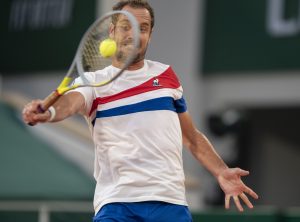No defending champion at the ATP Finals had exited the tournament in the round robin stage since 2009. Rafael Nadal had never made it to the semis after losing a round robin match since 2007. Stefanos Tsitsipas would have hoped to see these records continue but Nadal turned the tide with a three-set victory over the 22-year-old. Nadal progressed to the semifinals despite his loss to Dominic Thiem two days before.
Tsitsipas had experienced losing to Nadal at the same stage of the tournament the year before. With that in mind, did the young Greek attempt to change his tactics?
Tsitsipas’ loss to Nadal in 2019
Before this week’s match, Mark Petchey, the former coach of Andy Murray, provided some insight into Tsitsipas’ loss in 2019. “It was super close except in one area. Tsitsipas did not create one break point opportunity against Nadal.” Petchey went on to explain why.
- Nadal’s first serve was directed to the backhand 54.5% of the time. This generally resulted in a weak return from Tsitsipas’ backhand with Nadal winning 85% of his first service points.
- 54% of Tsitsipas’ second serve returns landed mid-court allowing Nadal to get on the front foot and play a forehand 82% of the time.
- Tsitsipas failed to land his first serves close enough to the lines. This allowed Nadal to get a massive 84% of his returns into play, culminating in two breaks of serve from nine opportunities.
Following Petchey’s logic, the Tsitsipas loss was mainly due to his serve and return. Going into Thursday’s match his game plan should have been clear: serve closer to the lines and return second serves aggressively to the Nadal backhand. Did Tsitsipas have these tactics in mind? And if he did, why did he go on to lose the match?
The Tsitsipas return
The return is a shot that Tsitsipas will undoubtedly need to improve going forward. He has a career percentage of return games won on a hard court of 17.6%. Compare this to Rafa’s 29.0%.
Even by his own lowly standards, Tsitsipas underperformed on return in 2019’s match. His inability to generate a single break point must have been weighing heavily on his mind going into this year’s match. It should be noted the Nadal serve is by no means invincible; there have only been six previous matches on a hard court where Nadal had not faced a break point. The pressure was on this year to step up on return.
Tsitsipas improved on last year’s return winning percentage but overall failed to deliver. He created three break point opportunities, taking two of them for a 14.3% winning percentage on return games. It was not nearly enough for Tsitsipas to take the match as Nadal surpassed him on return. Rafa stayed true to his career return winning percentage of 29%, breaking four times from eight break point opportunities.
In line with Petchey’s comment, Tsitsipas aimed to get the return deeper in the court than last year. He returned past the service line approximately 69.4% of the time when his return went in. This was however likely not the reason for him breaking Nadal’s serve twice. Nadal was frequently able to neutralize the return, on both first and second serves, rarely allowing Tsitsipas to get a foothold on a return point. The position of the return rarely made an impact on the outcome of the point, never more than in the final set when Tsitsipas returned past the service line in every return point he lost.
Improving the Tsitsipas return
For Tsitsipas to take control of a Nadal service point he needs width on the return as well as depth. There was only one return throughout the match that he was able to guide to within approximately a meter of the line. Perhaps this is easier said than done if Nadal continues to serve to the backhand as he did on Thursday but Tsitsipas should be looking to practice deep and wide returns to the deuce court in the off-season.
The Tsitsipas serve
Mark Petchey suggested that Tsitsipas had to find a more accurate serve as opposed to a faster one and Tsitsipas underlines this in this year’s match.
In the first set Tsitsipas increased his 2019 average first service speed from approximately 124mph to 129mph but Nadal made 90% of returns regardless. This was due to his return position standing very deep in the court, allowing him to neutralize serves fired too close to the body.
In the second set Tsitsipas found the edges of the service box more often. This does not translate statistically into aces as Nadal is able to get a racket on most serves. What does reflect this change is his increase in first service points won from 74% to 88%. He was also able to keep the points short due to a weak reply from Nadal, winning 20 points under five shots to Nadal’s 11. A further stat that suggests this more accurate serve is Nadal’s returned serves dropping from 90% to 69%.
Tsitsipas failing to hit the lines on his serve was particularly evident in the third set. He won a single service point when serving into the ad court and won only 36% of his second serves. This vulnerability on serve left him going for the wrong groundstrokes resulting in only one winner and 11 unforced errors in the set.
Improving the Tsitsipas serve
Overall, the Tsitsipas serve failed to overcome Nadal’s deep return position. This is illustrated by Nadal making 81% of returns in the match, slightly less than 2019’s 84%. To exploit Nadal’s deep return position, Tsitsipas should consider a serve-volley strategy. The Greek waited until his second service game of the third set to serve and volley, employing this tactic three times in a row. As an accomplished volleyer he won that service game comfortably. With Rafa standing so far back it becomes less imperative that Tsitsipas serve hits the lines. It should not be employed throughout the entirety of the match as Nadal is able to adapt but used sporadically, the Greek could likely have reinforced his already solid serve.
How can Tsitsipas improve against Nadal in the future?
Nadal’s serve will continue to batter Tsitsipas’ backhand but developing a return that is deep and wide to the Rafa backhand is definitely achievable: Dominic Thiem and Roger Federer have learnt to take the ball on the rise with their single handers, directing it down the line to dominate Nadal’s backhand.
The Greek will need to prioritize accuracy over power when serving. He was often accurate on serve but this is difficult to sustain for a whole match. Nadal will likely get the ball into play given his return stance so serving and volleying could be utilized effectively. This would take some pressure off serving immaculately from start to finish.
Rafael Nadal is not going anywhere any time soon. He is #2 in the world and is still winning the biggest titles tennis has to offer. Stefanos Tsitsipas will need to make peace with this fact and improve his weaponry specifically to dominate their rivalry.
Main Photo from Getty.






